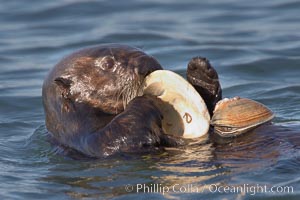
A sea otter eats a clam that it has taken from the shallow sandy bottom of Elkhorn Slough. Because sea otters have such a high metabolic rate, they eat up to 30% of their body weight each day in the form of clams, mussels, urchins, crabs and abalone. Sea otters are the only known tool-using marine mammal, using a stone or old shell to open the shells of their prey as they float on their backs.
Species: Sea otter, Enhydra lutris
Location: Elkhorn Slough National Estuarine Research Reserve, Moss Landing, California
Image ID: 21609
Species: Sea otter, Enhydra lutris
Location: Elkhorn Slough National Estuarine Research Reserve, Moss Landing, California
Image ID: 21609
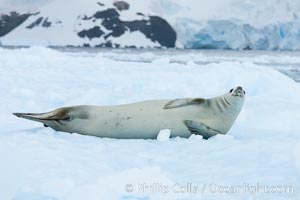
A crabeater seal, hauled out on pack ice to rest. Crabeater seals reach 2m and 200kg in size, with females being slightly larger than males. Crabeaters are the most abundant species of seal in the world, with as many as 75 million individuals. Despite its name, 80% the crabeater seal's diet consists of Antarctic krill. They have specially adapted teeth to strain the small krill from the water.
Species: Crabeater seal, Lobodon carcinophagus
Location: Cierva Cove, Antarctic Peninsula, Antarctica
Image ID: 25576
Species: Crabeater seal, Lobodon carcinophagus
Location: Cierva Cove, Antarctic Peninsula, Antarctica
Image ID: 25576
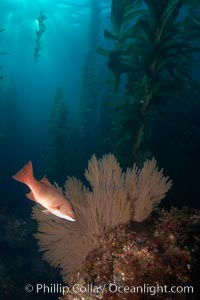
Sheephead and golden gorgonian, underwater in a kelp forest.
Species: California golden gorgonian, Muricea californica, Semicossyphus pulcher
Location: San Clemente Island, California
Image ID: 23528
Species: California golden gorgonian, Muricea californica, Semicossyphus pulcher
Location: San Clemente Island, California
Image ID: 23528
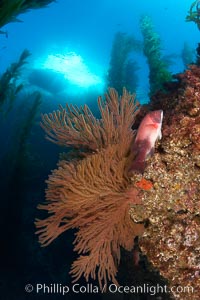
Gorgonians grow on rocky reef, kelp forest and a white boat floating on the surface can be seen in the background, underwater.
Species: California golden gorgonian, Muricea californica, Semicossyphus pulcher
Location: San Clemente Island, California
Image ID: 23537
Species: California golden gorgonian, Muricea californica, Semicossyphus pulcher
Location: San Clemente Island, California
Image ID: 23537
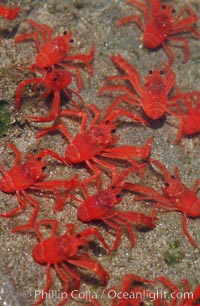
Pelagic red tuna crabs, washed ashore in tidepool.
Species: Pelagic red crab, Pleuroncodes planipes
Location: Ocean Beach, California
Image ID: 06062
Species: Pelagic red crab, Pleuroncodes planipes
Location: Ocean Beach, California
Image ID: 06062
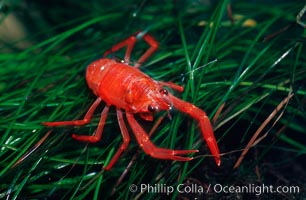
Pelagic red tuna crabs, washed ashore in tidepool.
Species: Pelagic red crab, Pleuroncodes planipes
Location: Ocean Beach, California
Image ID: 06065
Species: Pelagic red crab, Pleuroncodes planipes
Location: Ocean Beach, California
Image ID: 06065
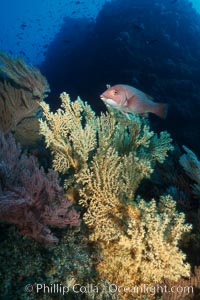
Juvenile sheephead swims above dead/dying brown gorgonian covered with yellow parasitic zoanthid anemones. Eagle Rock.
Species: California sheephead wrasse, Luminescent parazoanthid, Parazoanthus lucificum, Savalia lucifica, Semicossyphus pulcher
Location: Catalina Island, California
Image ID: 07006
Species: California sheephead wrasse, Luminescent parazoanthid, Parazoanthus lucificum, Savalia lucifica, Semicossyphus pulcher
Location: Catalina Island, California
Image ID: 07006
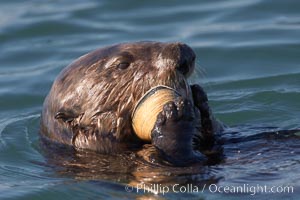
A sea otter eats a clam that it has taken from the shallow sandy bottom of Elkhorn Slough. Because sea otters have such a high metabolic rate, they eat up to 30% of their body weight each day in the form of clams, mussels, urchins, crabs and abalone. Sea otters are the only known tool-using marine mammal, using a stone or old shell to open the shells of their prey as they float on their backs.
Species: Sea otter, Enhydra lutris
Location: Elkhorn Slough National Estuarine Research Reserve, Moss Landing, California
Image ID: 21622
Species: Sea otter, Enhydra lutris
Location: Elkhorn Slough National Estuarine Research Reserve, Moss Landing, California
Image ID: 21622
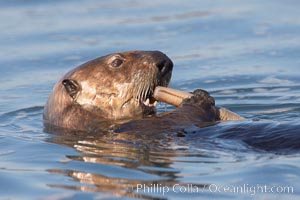
A sea otter eats a clam that it has taken from the shallow sandy bottom of Elkhorn Slough. Because sea otters have such a high metabolic rate, they eat up to 30% of their body weight each day in the form of clams, mussels, urchins, crabs and abalone. Sea otters are the only known tool-using marine mammal, using a stone or old shell to open the shells of their prey as they float on their backs.
Species: Sea otter, Enhydra lutris
Location: Elkhorn Slough National Estuarine Research Reserve, Moss Landing, California
Image ID: 21640
Species: Sea otter, Enhydra lutris
Location: Elkhorn Slough National Estuarine Research Reserve, Moss Landing, California
Image ID: 21640
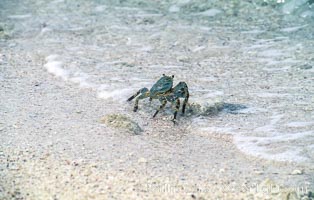
Crab on Sand at Rose Atoll NWR, American Samoa.
Location: Rose Atoll National Wildlife Refuge, American Samoa
Image ID: 00835
Location: Rose Atoll National Wildlife Refuge, American Samoa
Image ID: 00835
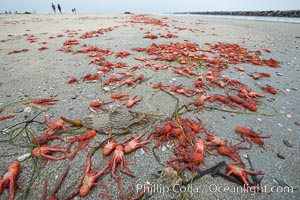
Pelagic red tuna crabs, washed ashore to form dense piles on the beach.
Species: Pelagic red crab, Pleuroncodes planipes
Location: Ocean Beach, California
Image ID: 30980
Species: Pelagic red crab, Pleuroncodes planipes
Location: Ocean Beach, California
Image ID: 30980
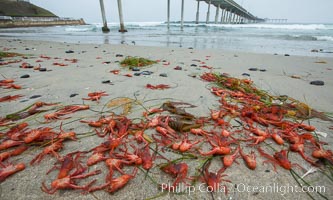
Pelagic red tuna crabs, washed ashore to form dense piles on the beach.
Species: Pelagic red crab, Pleuroncodes planipes
Location: Ocean Beach, California
Image ID: 30981
Species: Pelagic red crab, Pleuroncodes planipes
Location: Ocean Beach, California
Image ID: 30981
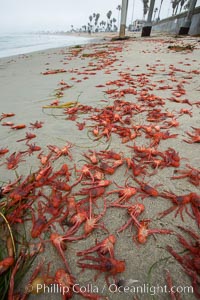
Pelagic red tuna crabs, washed ashore to form dense piles on the beach.
Species: Pelagic red crab, Pleuroncodes planipes
Location: Ocean Beach, California
Image ID: 30983
Species: Pelagic red crab, Pleuroncodes planipes
Location: Ocean Beach, California
Image ID: 30983
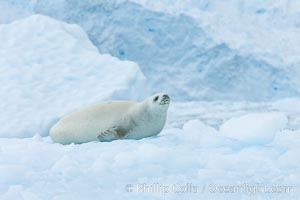
A crabeater seal, hauled out on pack ice to rest. Crabeater seals reach 2m and 200kg in size, with females being slightly larger than males. Crabeaters are the most abundant species of seal in the world, with as many as 75 million individuals. Despite its name, 80% the crabeater seal's diet consists of Antarctic krill. They have specially adapted teeth to strain the small krill from the water.
Species: Crabeater seal, Lobodon carcinophagus
Location: Cierva Cove, Antarctic Peninsula, Antarctica
Image ID: 25525
Species: Crabeater seal, Lobodon carcinophagus
Location: Cierva Cove, Antarctic Peninsula, Antarctica
Image ID: 25525
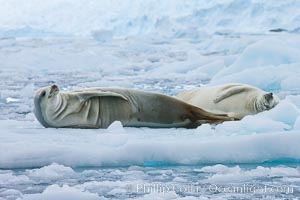
Crabeater seal resting on pack ice. Crabeater seals reach 2m and 200kg in size, with females being slightly larger than males. Crabeaters are the most abundant species of seal in the world, with as many as 75 million individuals. Despite its name, 80% the crabeater seal's diet consists of Antarctic krill. They have specially adapted teeth to strain the small krill from the water.
Species: Crabeater seal, Lobodon carcinophagus
Location: Cierva Cove, Antarctic Peninsula, Antarctica
Image ID: 25530
Species: Crabeater seal, Lobodon carcinophagus
Location: Cierva Cove, Antarctic Peninsula, Antarctica
Image ID: 25530
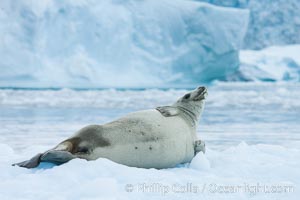
A crabeater seal, hauled out on pack ice to rest. Crabeater seals reach 2m and 200kg in size, with females being slightly larger than males. Crabeaters are the most abundant species of seal in the world, with as many as 75 million individuals. Despite its name, 80% the crabeater seal's diet consists of Antarctic krill. They have specially adapted teeth to strain the small krill from the water.
Species: Crabeater seal, Lobodon carcinophagus
Location: Cierva Cove, Antarctic Peninsula, Antarctica
Image ID: 25577
Species: Crabeater seal, Lobodon carcinophagus
Location: Cierva Cove, Antarctic Peninsula, Antarctica
Image ID: 25577
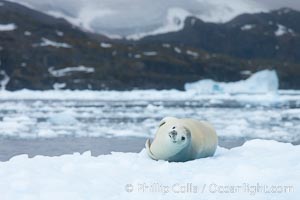
Crabeater seal resting on pack ice. Crabeater seals reach 2m and 200kg in size, with females being slightly larger than males. Crabeaters are the most abundant species of seal in the world, with as many as 75 million individuals. Despite its name, 80% the crabeater seal's diet consists of Antarctic krill. They have specially adapted teeth to strain the small krill from the water.
Species: Crabeater seal, Lobodon carcinophagus
Location: Cierva Cove, Antarctic Peninsula, Antarctica
Image ID: 25579
Species: Crabeater seal, Lobodon carcinophagus
Location: Cierva Cove, Antarctic Peninsula, Antarctica
Image ID: 25579
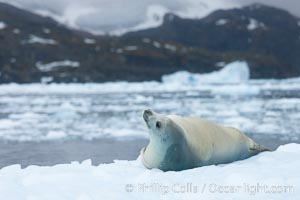
Crabeater seal resting on pack ice. Crabeater seals reach 2m and 200kg in size, with females being slightly larger than males. Crabeaters are the most abundant species of seal in the world, with as many as 75 million individuals. Despite its name, 80% the crabeater seal's diet consists of Antarctic krill. They have specially adapted teeth to strain the small krill from the water.
Species: Crabeater seal, Lobodon carcinophagus
Location: Cierva Cove, Antarctic Peninsula, Antarctica
Image ID: 25580
Species: Crabeater seal, Lobodon carcinophagus
Location: Cierva Cove, Antarctic Peninsula, Antarctica
Image ID: 25580
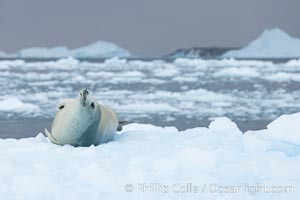
Crabeater seal resting on pack ice. Crabeater seals reach 2m and 200kg in size, with females being slightly larger than males. Crabeaters are the most abundant species of seal in the world, with as many as 75 million individuals. Despite its name, 80% the crabeater seal's diet consists of Antarctic krill. They have specially adapted teeth to strain the small krill from the water.
Species: Crabeater seal, Lobodon carcinophagus
Location: Cierva Cove, Antarctic Peninsula, Antarctica
Image ID: 25581
Species: Crabeater seal, Lobodon carcinophagus
Location: Cierva Cove, Antarctic Peninsula, Antarctica
Image ID: 25581
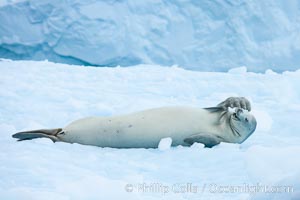
A crabeater seal, hauled out on pack ice to rest. Crabeater seals reach 2m and 200kg in size, with females being slightly larger than males. Crabeaters are the most abundant species of seal in the world, with as many as 75 million individuals. Despite its name, 80% the crabeater seal's diet consists of Antarctic krill. They have specially adapted teeth to strain the small krill from the water.
Species: Crabeater seal, Lobodon carcinophagus
Location: Cierva Cove, Antarctic Peninsula, Antarctica
Image ID: 25582
Species: Crabeater seal, Lobodon carcinophagus
Location: Cierva Cove, Antarctic Peninsula, Antarctica
Image ID: 25582
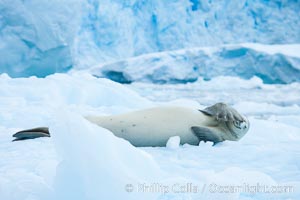
A crabeater seal, hauled out on pack ice to rest. Crabeater seals reach 2m and 200kg in size, with females being slightly larger than males. Crabeaters are the most abundant species of seal in the world, with as many as 75 million individuals. Despite its name, 80% the crabeater seal's diet consists of Antarctic krill. They have specially adapted teeth to strain the small krill from the water.
Species: Crabeater seal, Lobodon carcinophagus
Location: Cierva Cove, Antarctic Peninsula, Antarctica
Image ID: 25583
Species: Crabeater seal, Lobodon carcinophagus
Location: Cierva Cove, Antarctic Peninsula, Antarctica
Image ID: 25583
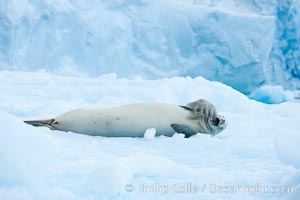
A crabeater seal, hauled out on pack ice to rest. Crabeater seals reach 2m and 200kg in size, with females being slightly larger than males. Crabeaters are the most abundant species of seal in the world, with as many as 75 million individuals. Despite its name, 80% the crabeater seal's diet consists of Antarctic krill. They have specially adapted teeth to strain the small krill from the water.
Species: Crabeater seal, Lobodon carcinophagus
Location: Cierva Cove, Antarctic Peninsula, Antarctica
Image ID: 25584
Species: Crabeater seal, Lobodon carcinophagus
Location: Cierva Cove, Antarctic Peninsula, Antarctica
Image ID: 25584
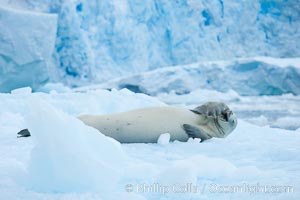
A crabeater seal, hauled out on pack ice to rest. Crabeater seals reach 2m and 200kg in size, with females being slightly larger than males. Crabeaters are the most abundant species of seal in the world, with as many as 75 million individuals. Despite its name, 80% the crabeater seal's diet consists of Antarctic krill. They have specially adapted teeth to strain the small krill from the water.
Species: Crabeater seal, Lobodon carcinophagus
Location: Cierva Cove, Antarctic Peninsula, Antarctica
Image ID: 25585
Species: Crabeater seal, Lobodon carcinophagus
Location: Cierva Cove, Antarctic Peninsula, Antarctica
Image ID: 25585
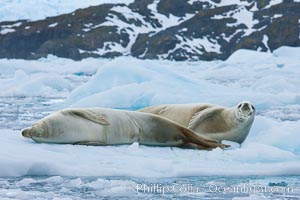
Crabeater seal resting on pack ice. Crabeater seals reach 2m and 200kg in size, with females being slightly larger than males. Crabeaters are the most abundant species of seal in the world, with as many as 75 million individuals. Despite its name, 80% the crabeater seal's diet consists of Antarctic krill. They have specially adapted teeth to strain the small krill from the water.
Species: Crabeater seal, Lobodon carcinophagus
Location: Cierva Cove, Antarctic Peninsula, Antarctica
Image ID: 25597
Species: Crabeater seal, Lobodon carcinophagus
Location: Cierva Cove, Antarctic Peninsula, Antarctica
Image ID: 25597
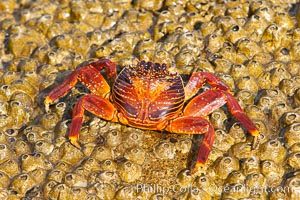
Sally lightfoot crab on barnacles.
Species: Sally lightfoot crab, Grapsus grapsus
Location: North Seymour Island, Galapagos Islands, Ecuador
Image ID: 16604
Species: Sally lightfoot crab, Grapsus grapsus
Location: North Seymour Island, Galapagos Islands, Ecuador
Image ID: 16604
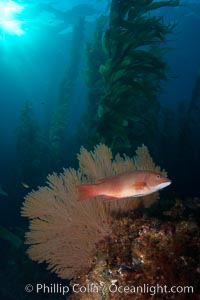
Sheephead and golden gorgonian, underwater in a kelp forest.
Species: California golden gorgonian, Muricea californica, Semicossyphus pulcher
Location: San Clemente Island, California
Image ID: 23586
Species: California golden gorgonian, Muricea californica, Semicossyphus pulcher
Location: San Clemente Island, California
Image ID: 23586
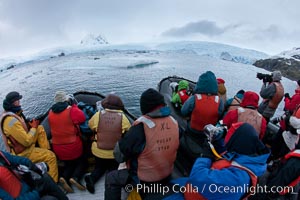
Photographers enjoy a crabeater seal, from two inflatable zodiacs in Cierva Cove.
Location: Cierva Cove, Antarctic Peninsula, Antarctica
Image ID: 25593
Location: Cierva Cove, Antarctic Peninsula, Antarctica
Image ID: 25593
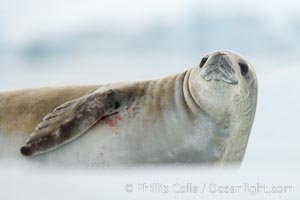
A crabeater seal, hauled out on pack ice to rest. Crabeater seals reach 2m and 200kg in size, with females being slightly larger than males. Crabeaters are the most abundant species of seal in the world, with as many as 75 million individuals. Despite its name, 80% the crabeater seal's diet consists of Antarctic krill. They have specially adapted teeth to strain the small krill from the water.
Species: Crabeater seal, Lobodon carcinophagus
Location: Neko Harbor, Antarctic Peninsula, Antarctica
Image ID: 25650
Species: Crabeater seal, Lobodon carcinophagus
Location: Neko Harbor, Antarctic Peninsula, Antarctica
Image ID: 25650
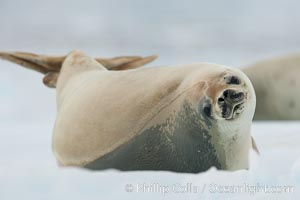
A crabeater seal, hauled out on pack ice to rest. Crabeater seals reach 2m and 200kg in size, with females being slightly larger than males. Crabeaters are the most abundant species of seal in the world, with as many as 75 million individuals. Despite its name, 80% the crabeater seal's diet consists of Antarctic krill. They have specially adapted teeth to strain the small krill from the water.
Species: Crabeater seal, Lobodon carcinophagus
Location: Neko Harbor, Antarctic Peninsula, Antarctica
Image ID: 25664
Species: Crabeater seal, Lobodon carcinophagus
Location: Neko Harbor, Antarctic Peninsula, Antarctica
Image ID: 25664
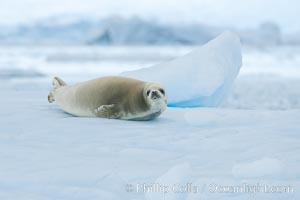
A crabeater seal, hauled out on pack ice to rest. Crabeater seals reach 2m and 200kg in size, with females being slightly larger than males. Crabeaters are the most abundant species of seal in the world, with as many as 75 million individuals. Despite its name, 80% the crabeater seal's diet consists of Antarctic krill. They have specially adapted teeth to strain the small krill from the water.
Species: Crabeater seal, Lobodon carcinophagus
Location: Neko Harbor, Antarctic Peninsula, Antarctica
Image ID: 25673
Species: Crabeater seal, Lobodon carcinophagus
Location: Neko Harbor, Antarctic Peninsula, Antarctica
Image ID: 25673